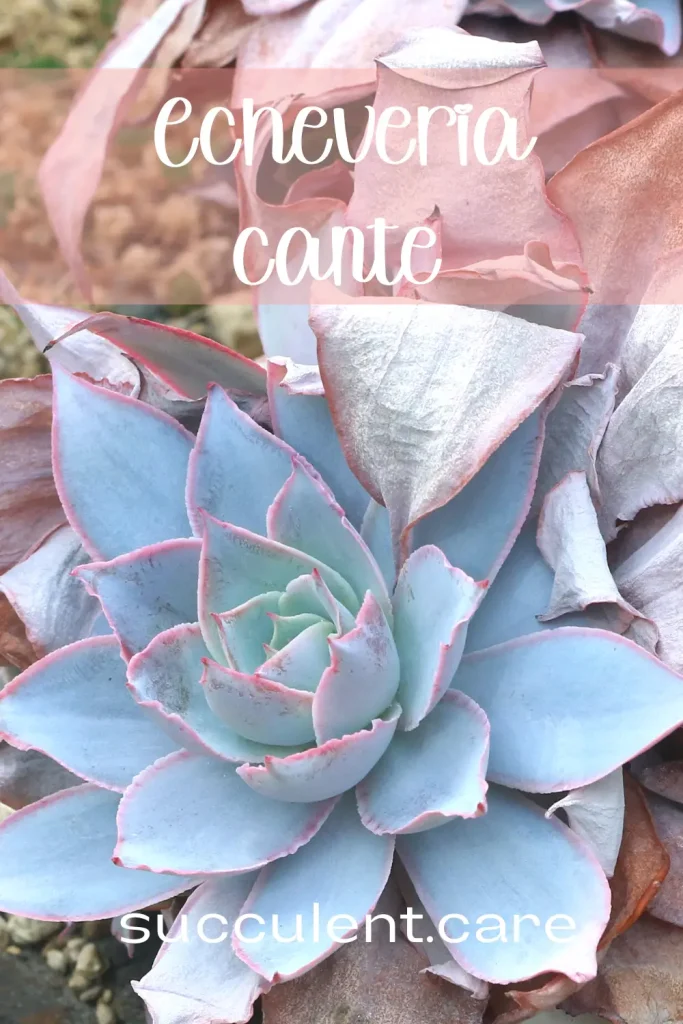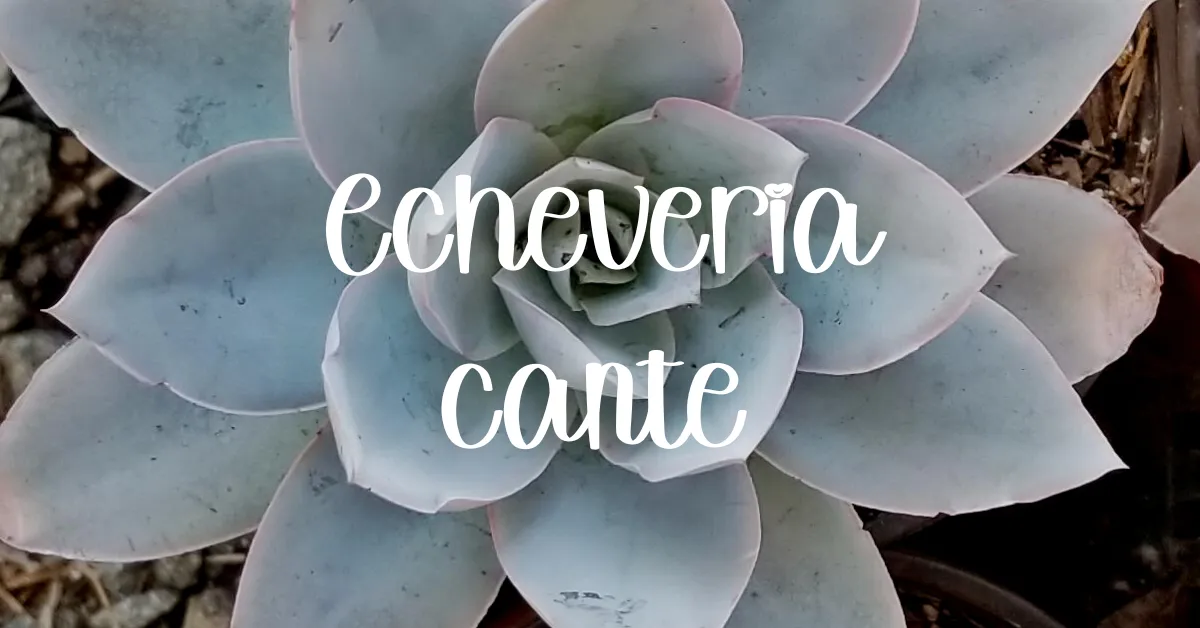Echeveria cante is a stunning succulent plant that belongs to the Crassulaceae family. With its rosette-shaped leaves and vibrant colors, Echeveria cante is a popular choice among succulent enthusiasts. In this comprehensive care guide, we will explore everything you need to know to keep your Echeveria cante healthy and thriving.
Dig in!
Description
Echeveria cante is a visually striking succulent with thick, fleshy leaves arranged in a rosette formation. The leaves are a bluish-green color, often with a hint of purple or pink on the edges. The plant has a compact growth habit and can reach a size of up to 10 inches (25 centimeters) in diameter when fully grown.

Flower Description and Bloom Time
Echeveria cante produces tall flower stalks that emerge from the center of the rosette. The flowers are bell-shaped and typically have orange or yellow petals. The bloom time for Echeveria cante is typically in the late spring or early summer, although individual plants may vary slightly.

Source: Etsy
Echeveria cante Care Guide
Light Requirements
Echeveria cante thrives in bright light conditions. It is best to place it in a location where it can receive at least six hours of direct sunlight per day. However, be cautious of intense afternoon sun, as it can scorch the leaves. If you are growing Echeveria cante indoors, place it near a south-facing window or provide supplemental grow lights.

Watering
Like most succulents, Echeveria cante has low water needs. It is important to allow the soil to dry out between waterings to prevent root rot. As a general guideline, water your Echeveria cante thoroughly when the top inch of the soil feels dry. During the winter months, reduce watering frequency as the plant enters a period of dormancy.
When you’re rooting or transplanting your succulents and cacti, use SUPERthrive to help reduce the chance of transplant shock and grow a strong root system.
Soil Requirements
Echeveria cante thrives in well-draining soil that replicates its natural habitat. A combination of potting soil and perlite or pumice works well to ensure proper drainage. Avoid using heavy or moisture-retaining soils, as they can lead to root rot.

Consider amending your soil with Bonsai Jack’s gritty mix to ensure your succulent soil drains quickly to prevent it from staying moist for too long. Source: Etsy
Temperature Tolerance
Echeveria cante is a hardy succulent and can tolerate a wide range of temperatures. It can withstand temperatures as low as 20°F (-6°C) but prefers temperatures between 50°F (10°C) and 80°F (27°C). Protect the plant from frost and freezing temperatures, as prolonged exposure can damage the leaves.
USDA Hardiness Zone
Echeveria cante is best suited for USDA hardiness zones 9 to 11. In colder regions, it is recommended to grow Echeveria cante as a potted plant that can be brought indoors during winter.
Fertilizing
To keep your Echeveria cante healthy and promote optimal growth, it is recommended to fertilize it sparingly. Use a balanced, water-soluble fertilizer specifically formulated for succulents. Apply the fertilizer at half the recommended strength once every two to three months during the growing season.

Succulent fertilizer available to purchase on Etsy.
Repotting
Echeveria cante generally does not require frequent repotting. Repotting every two to three years is usually sufficient, or when the plant has outgrown its current container. When repotting, choose a slightly larger pot with good drainage and use fresh succulent potting mix.
Propagating Echeveria cante
The easiest way to propagate Echeveria cante is through stem cuttings.
Here’s a step-by-step guide on how to propagate Echeveria cante through stem cuttings:
- Prepare the materials: Gather a sharp, clean pair of pruning shears or scissors, a clean work surface, a well-draining potting mix suitable for succulents, and small pots or containers for planting the cuttings.
- Select a healthy stem: Look for a mature, healthy stem on the Echeveria cante plant that you want to propagate. Choose a stem that is not too woody or too young but has firm, plump leaves.
- Take a cutting: Using the pruning shears or scissors, make a clean cut just below a leaf node on the selected stem. A leaf node is where the leaves attach to the stem. Aim for a cutting that is approximately 3-4 inches long.
- Let the cutting callus: After taking the cutting, set it aside in a dry, shaded area for a few days to allow the cut end to callus over. This callusing process helps prevent the cutting from rotting when planted.
- Prepare the potting mix: While the cutting is callusing, prepare a well-draining potting mix suitable for succulents. You can either purchase a commercial succulent mix or create your own by combining regular potting soil with perlite or coarse sand for improved drainage.
- Plant the cutting: Once the cutting has callused, it’s time to plant it. Fill a small pot or container with the potting mix, leaving about an inch of space at the top. Make a small hole in the center of the soil and gently place the cut end of the stem into the hole, ensuring that at least one leaf node is buried in the soil.
- Provide proper care: After planting, water the cutting lightly, making sure not to overwater. Echeverias are susceptible to root rot, so it’s important to let the soil dry out between waterings. Place the pot in a bright, indirect light location, as Echeverias need ample sunlight to thrive.
- Monitor and wait: Over the next few weeks, keep an eye on the cutting and ensure the soil remains slightly moist but not soggy. Avoid direct sunlight, as it can scorch the delicate cutting. After a few weeks, new roots and leaves should start to develop.
- Transplanting: Once the cutting has developed a strong root system and several new leaves, it is ready to be transplanted into a larger pot or directly into the garden if desired. Be gentle when handling the young plant and avoid damaging the delicate roots.
- Care for the new plant: After transplanting, continue to care for the Echeveria cante by providing it with adequate sunlight, well-draining soil, and occasional watering. These succulents prefer a dry, arid environment and thrive in temperatures between 60-75°F (15-24°C).
Remember, propagating Echeveria cante takes time and patience. Not every cutting will successfully root, so it’s a good idea to take several cuttings to increase your chances of success. With proper care, you can enjoy a flourishing collection of Echeveria cante plants in no time.
Common Pests and Treatment
Echeveria cante is generally resistant to pests but can occasionally attract common succulent pests such as mealybugs and aphids. To treat these pests, isolate the affected plant and wipe the leaves with a cotton swab dipped in rubbing alcohol. For severe infestations, use an organic insecticidal soap or neem oil according to the manufacturer’s instructions.
Common Problems and Solutions
One common problem with Echeveria cante is root rot, which occurs when the plant is overwatered or exposed to soggy soil conditions. To prevent root rot, ensure that the soil is well-draining and allow it to dry out between waterings. Yellowing or wilting leaves may indicate underwatering. Increase the frequency of watering and make sure the plant receives adequate sunlight.
Growing Indoors
Echeveria cante can be successfully grown indoors, making it agreat choice for indoor gardening enthusiasts. To grow Echeveria cante indoors, follow these tips:
- Place the plant near a south-facing window or provide supplemental grow lights to ensure it receives enough bright light.
- Maintain a temperature range between 50°F (10°C) and 80°F (27°C) to mimic its preferred conditions.
- Water the plant sparingly, allowing the soil to dry out between waterings. Be cautious not to overwater, as this can lead to root rot.
- Use well-draining soil and a pot with drainage holes to prevent water from pooling at the bottom.
- Rotate the plant occasionally to ensure even growth and prevent it from leaning towards the light source.
Echeveria cante, with its stunning rosette shape and vibrant colors, is a beautiful addition to any succulent collection. By providing the right care, including adequate light, well-draining soil, and proper watering, you can enjoy a healthy and thriving Echeveria cante in your home or garden. Remember to monitor the plant for any signs of pests or diseases and take appropriate action to maintain its health. Enjoy the beauty of Echeveria cante and the joy of succulent gardening!









